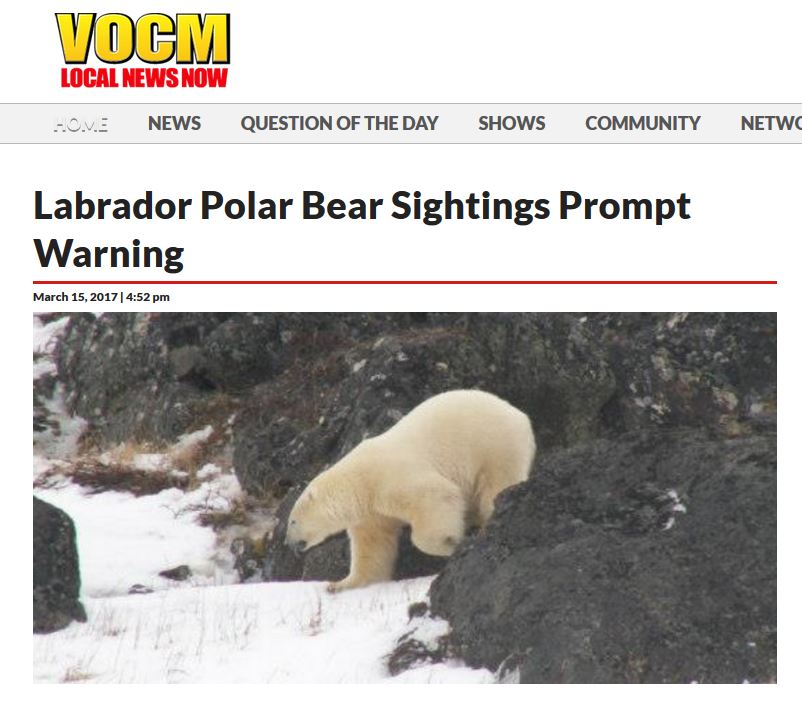Pack ice is barreling down the Labrador coast, almost certainly bringing Davis Strait polar bears with it. And according to new survey results, those bears are doing just fine: numbers are stable, bears are fatter than they were in 2007, and cubs are surviving well – thanks largely to abundant harp seals.
According to the summary, the 2017-2018 survey generated a population estimate of 2,015 (range 1,603-2,588), which is statistically indistinguishable from the 2005-2007 study estimate of 2,158 (range 1,978-2,338). Notice the range of potential error is much larger for the most recent estimate, which is a result of different methods used (Dyck et al. 2021; Peacock et al. 2013). No bears were captured and collared for the 2018 study (the full report has not yet been made public).
What’s interesting is that in 2007, the body condition of bears was noted to have been worse than it had been in the 1990s yet the population size had increased markedly (Rode et al. 2012). Now body condition of bears has improved but numbers have not increased.
I suggest that it’s quite possible the actual number of bears in the population is at least somewhat greater than the official estimate indicates: that the real number lies closer to the higher end of the estimated range rather than at the middle. Of course, that’s always the case because these estimates are based on counting a subsample of bears and extrapolating to the entire region using a mathematical model.
However, this is why other indicators are important. Good body condition and good cub survival indicate a population that’s in good shape. Similar indicators have been seen in the Barents Sea and Chukchi Sea subpopulations (Aars et al. 2017; Norwegian Polar Institute 2021; Rode et al. 2014, 2018).
Certainly, 2017 and 2018 stood out as having many more sightings of bears along the Labrador and northern Newfoundland coast than there were in 2007. In contrast, sea ice was extensive along that coast in 2007 yet there were no sightings of polar bears reported.
There were several sightings in 2008 and a spate of trouble in 2012 that resulted in a few bears being killed for safety concerns. Then in 2017 and 2018 – the same years of the most recent population survey – there were reports of many more sightings: at least nine in 2017 amid extensive ice and even more (12-18) in 2018 (Crockford 2020:34).
Labrador sea ice 2022
Big picture first:

Sea ice conditions this year show Davis Strait ice (light green) moving south rapidly against thinner, newly-formed ice (purple) along the coast.

Compare above to 2017, when the ice was very thick later in the season north of Newfoundland: thicker, first year ice from the north (light green) had replaced virtually all new ice along the coast.

Time will tell if the pack ice off Newfoundland in April will be as thick as it was in 2017 but at the moment, conditions are looking good for East Coast harp seals set to give birth to pups in March and the Davis Strait polar bears that come to feed on them.
References
Aars, J., Marques,T.A, Lone, K., Anderson, M., Wiig, Ø., Fløystad, I.M.B., Hagen, S.B. and Buckland, S.T. 2017. The number and distribution of polar bears in the western Barents Sea, Polar Research 36:1, 1374125.
Crockford, S.J. 2020. State of the Polar Bear 2019. Global Warming Policy Foundation Report 39.
Dyck, M., Dunham, K.D., Ware, J.V., Koons, D.N., Regehr, E.V., Hosmer, D.W., Derocher, A.E., Dale, A., Pisapio, J. and Szor, G. 2021. Re-estimating the abundance of the Davis Strait polar bear subpopulation by genetic mark-recapture. Final Report to Nunavut Wildlife Boards. Government of Nunavut, Igloolik, 17 December. Two page summary and title page provided by A.E. Derocher via Twitter https://twitter.com/AEDerocher/status/1473001033257218051; the entire final report had not yet been made public by the time this report was written.
Norwegian Polar Institute. 2021. Polar bear cubs per litter, number of females with cubs of different ages, and condition in adult polar bear males. Environmental monitoring of Svalbard and Jan Mayen (MOSJ), 8 September. http://www.mosj.no/en/fauna/marine/polar-bear.html
Peacock, E., Taylor, M.K., Laake, J., and Stirling, I. 2013. Population ecology of polar bears in Davis Strait, Canada and Greenland. Journal of Wildlife Management 77:463–476
Rode, K.D., Peacock, E., Taylor, M., Stirling, I., Born, E.W., Laidre, K.L., and Wiig, Ø. 2012. A tale of two polar bear populations: ice habitat, harvest, and body condition. Population Ecology 54:3-18. http://link.springer.com/article/10.1007/s10144-011-0299-9
Rode, K.D., Regehr, E.V., Douglas, D., Durner, G., Derocher, A.E., Thiemann, G.W., and Budge, S. 2014. Variation in the response of an Arctic top predator experiencing habitat loss: feeding and reproductive ecology of two polar bear populations. Global Change Biology 20(1):76–88.
Rode, K.D., Wilson, R.R., Douglas, D.C., Muhlenbruch, V., Atwood, T.C., Regehr, E.V., Richardson, E.S., Pilfold, N.W., Derocher, A.E., Durner, G.M., Stirling, I., Amstrup, S.C., St. Martin, M., Pagano, A.M. and Simac, K. 2018. Spring fasting behavior in a marine apex predator provides an index of ecosystem productivity. Global Change Biology 24(1):410-423.
via polarbearscience
January 31, 2022 at 07:25PM


